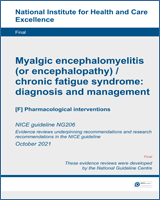From: Pharmacological interventions

NCBI Bookshelf. A service of the National Library of Medicine, National Institutes of Health.
| Outcomes | No of Participants (studies*) Follow up | Quality of the evidence (GRADE) | Relative effect (95% CI) | Anticipated absolute effects | |
|---|---|---|---|---|---|
| Risk with Control | Risk difference with 5-HT3 antagonists (ondansetron) versus placebo (95% CI) | ||||
|
Fatigue: Checklist Individual Strength fatigue Scale from: 8 to 56. |
67 (1 study) 12 weeks |
⊕⊝⊝⊝ due to risk of bias, indirectness, imprecision |
The mean fatigue: cis fatigue at 12 weeks in the control groups was 45.4 |
The mean fatigue: cis fatigue at 12 weeks in the intervention groups was 1.4 lower (6.81 lower to 4.01 higher) | |
| Activity levels: Actometer (objective accelerometer-based method of measuring activity) |
67 (1 study) 12 weeks |
⊕⊝⊝⊝ due to risk of bias, indirectness, imprecision |
The mean activity levels: actometer (objective accelerometer-based method of measuring activity) at 12 weeks in the control groups was 60.6 |
The mean activity levels: actometer (objective accelerometer-based method of measuring activity) at 12 weeks in the intervention groups was 5.6 lower (13.61 lower to 2.41 higher) | |
| Adverse events: constipation |
67 (1 study) 12 weeks |
⊕⊝⊝⊝ due to risk of bias, indirectness, imprecision | Peto OR 7.86 (0.48 to 128.37) | 0 per 1000 |
60 more per 1000 (from 40 fewer to 160 more) |
| Adverse events: malaise |
67 (1 study) 12 weeks |
⊕⊝⊝⊝ due to risk of bias, indirectness, imprecision | RR 3.09 (0.34 to 28.23) | 29 per 1000 |
61 more per 1000 (from 19 fewer to 801 more) |
|
Symptom scales: Sickness Impact Profile (SIP) 8 Scale from: 0 to 5799. |
67 (1 study) 12 weeks |
⊕⊝⊝⊝ due to risk of bias, indirectness, imprecision |
The mean symptom scales: sickness impact profile (sip) 8 at 12 weeks in the control groups was 1172 |
The mean symptom scales: sickness impact profile (sip) 8 at 12 weeks in the intervention groups was 109 lower (403.38 lower to 185.38 higher) | |
Downgraded by 1 increment if the majority of the evidence was at high risk of bias, and downgraded by 2 increments if the majority of the evidence was at very high risk of bias
The majority of the evidence included an indirect population (downgraded by one increment): downgraded if the ME/CFS diagnostic criteria used did not include PEM as a compulsory feature [original analysis]; percentage of participants with PEM unclear [PEM reanalysis – see Appendix G for additional details]
Downgraded by 1 increment if the confidence interval crossed one MID or by 2 increments if the confidence interval crossed both MIDs
Studies included: The 2010
From: Pharmacological interventions

NCBI Bookshelf. A service of the National Library of Medicine, National Institutes of Health.